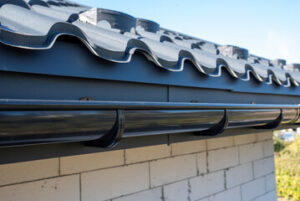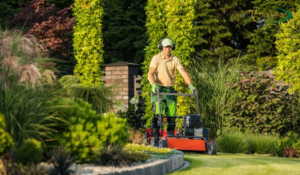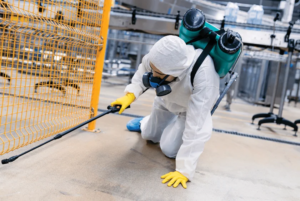Gutters are an important part of your home, protecting it from costly water damage and enhancing its value. Regular cleaning helps keep them free of clogs, allowing rainwater to drain away from your roof and walls without damaging them.

Clogged gutters can cause sagging, mold, basement leaks, and other problems. You can perform your own gutter cleaning with a ladder and some basic tools, but you’ll need to take safety precautions. Find Out More Here for more details.
Gutter cleaning involves removing leaves, twigs, debris, and other contaminants that collect in the gutter system. Debris can become a breeding ground for mosquitoes and other pests. Stagnant water can also become contaminated with decomposing leaves and organic material, leading to a thick sludge that can damage the integrity of your gutters and other parts of your home. Regular gutter cleaning can prevent these problems and ensure that rainwater flows correctly away from your house, rather than seeping through walls, damaging insulation, or soaking into the foundation.
While gutter cleaning may seem like a relatively simple chore, there are a lot of things to consider before you get started. Getting the job done properly requires the right tools and safety precautions. A sturdy ladder, safety harness, and gloves are essential for protecting yourself from falling debris while you work.
Start by covering any area where you plan to work with a tarp or sheet to keep the mess contained. Lay the tarp in front of any sections that you intend to clean and set up a bucket for collecting waste. Then, work your way over the entire gutter system. Use your hands or a gutter scoop to remove the larger pieces of debris. Be sure to check the downspouts as well; if they’re clogged, they may need to be snaked or flushed with a hose. Once you’ve removed all the visible debris, rinse the entire gutter system with a garden hose to wash down finer particles and verify that the gutters are flowing freely.
Gutter systems are designed to carry rainwater or snow/ice melt from your roof to the ground, with downspouts diverting the flow away from your home and landscaping. However, a dirty, clogged gutter system can lead to expensive home repairs, mold, wood rot, and pest infestations. Regular gutter cleaning can prevent these issues and protect your property from damage, so it’s worth the effort to do it right.
Clogged Downspouts
Clogged downspouts are a much bigger problem than you might think. They aren’t just inconvenient; they can actually damage your home and cause expensive problems down the line. Downspouts are meant to take the rainwater from your gutters and channel it away from your house. When they’re clogged, they can’t do their job properly, and it can lead to serious issues like water damage and foundation movement.
Downspout clogs are often caused by the same things that make your gutters full of debris: leaves, pine needles, small twigs, asphalt shingle grit, and more. These items may not seem like they would have a huge impact on your gutter system, but they can quickly accumulate and block your downspout. Once they do, it’s very difficult for them to be cleared without help from a ladder and other tools.
To prevent clogs, you should regularly clean out your gutters and check them after storms. You should also consider having gutter guards installed, which can reduce the amount of debris that ends up in your gutters and downspouts. If you find that your downspout is clogged, it’s important to use a ladder that can support you and follow all safety precautions while cleaning. You should also have a garden hose on hand to flush out your downspout if you can’t get the clog loose with a bucket of water.
If you’re unable to clear the clog with a garden hose, try using a plumber’s snake. It can be helpful to have a partner for this task, as one person can climb the ladder while the other holds the hose. Once you’re at the downspout, turn on the hose and slowly move it along the length of the clogged downspout to dislodge the clog and wash it away. Be careful not to use too much force, as you could end up damaging your downspout. Once the clog is gone, you can clean up the mess and use your hose to flush out the gutter once more. Then, you should check for any additional clogs and clear them as needed.
Sagging Gutters
Gutters are designed to route rainwater away from the house, but if they are sagging or pulling away, the water may overflow and cause water damage or pool around the foundation. This can be a big problem for homeowners, which is why it’s important to keep up with gutter cleaning projects. Keeping the gutters free of leaves, twigs and debris will help prevent sagging.
Gutter sagging can be caused by many things, but the most common reason is that the gutters are holding too much weight. The excess weight can be from a buildup of leaves and other debris, but it could also be from a heavy rainfall or snowfall. Over time, the excess weight can make the gutters loosen and pull away from the fascia boards.
Another possibility is that the gutters are simply old and starting to deteriorate. Over time, even the strongest gutter materials lose their strength and integrity due to age and exposure to elements like wind and sunlight. This can lead to leaks and sagging, and it’s important to replace them as soon as they start to break down.
The gutters can also sag due to improper installation or faulty fasteners. It’s important to properly install the gutters and make sure they have a proper slope so that they can drain correctly. If the gutters are not installed at the correct pitch, they will be more likely to sag and pull away from the home.
One of the easiest ways to fix sagging gutters is to clean out the entire system. This will remove any debris that has accumulated, as well as clear out any clogs in the downspouts. This should be done at least twice a year, but if you live in an area with a lot of trees, you may want to do it more frequently. Make sure to check for rust, loose or broken fasteners and other problems with the gutters when you’re cleaning them. And remember, never dump the mucky decomposed leaves from your gutters onto your lawn – this can kill your grass.
Plant Growth
The gutter system carries rainwater or snow/ice melt from the roof to the ground via downspouts that divert the flow away from the house and landscaping. However, when plants like vines or shrubbery grow in and around the gutters they can create a host of problems including blockages, overflows, and clogged downspouts. In addition, if they come in contact with the structure of the home or its foundation they can cause damage that may require costly repairs. Regular gutter cleaning helps to prevent these issues from developing by removing any plant growth that may be obstructing the gutter system.
In addition to the structural and aesthetic damage caused by plant growth, it is also a fire hazard. If dry plant material accumulates on buildings and gutter lines, it can easily catch alight posing serious risk of property damage as well as endangering lives. Gutter cleaning eliminates the buildup of plant material, reducing this risk and maintaining the integrity of the building and its gutter systems.
Another important reason to schedule regular gutter cleanings is the prevention of pest infestation. Pests and rodents find ideal breeding grounds in clogged gutters where leaves, twigs, and debris are plentiful. In addition, these organisms can infiltrate the structure of the home or business, causing further damage and posing health risks for its residents. Regular gutter cleanings get rid of the organic trash that attracts these organisms, preventing their breeding and proliferation.
The gutter cleaning process involves manual removal of larger debris and a thorough flushing with water. This helps to clear remaining smaller particles as well as check for clogged downspouts and signs of structural damage such as holes or rust. Professional gutter cleaners have the experience and equipment to handle these tasks safely and efficiently, ensuring their own safety as well as that of the building and its inhabitants. Gutter cleaning is a routine maintenance item that should be scheduled at least twice a year to ensure proper function and long-term durability. By following these simple tips, you can extend the lifespan of your gutter system, protect your home and its foundation, and enhance its aesthetics.








